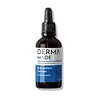What's inside
What's inside
 Key Ingredients
Key Ingredients

 Benefits
Benefits

 Concerns
Concerns

 Ingredients Side-by-side
Ingredients Side-by-side

Water
Skin ConditioningGlycerin
HumectantCaprylic/Capric Triglyceride
MaskingIsopentyldiol
HumectantTrioctyldodecyl Citrate
EmollientCitrullus Lanatus Seed Oil
Emollient1,2-Hexanediol
Skin ConditioningRubus Idaeus Seed Oil
EmollientPanthenol
Skin ConditioningTriolein
Skin ConditioningRetinal
Skin ConditioningCeramide NP
Skin ConditioningTocopherol
AntioxidantRetinol
Skin ConditioningTocopheryl Acetate
AntioxidantHaematococcus Pluvialis Extract
AntioxidantHydroxyethyl Acrylate/Sodium Acryloyldimethyl Taurate Copolymer
Emulsion StabilisingCopernicia Cerifera Wax
Pongamia Glabra Seed Oil
Skin ConditioningGlyceryl Dioleate
EmollientBisabolol
MaskingAllantoin
Skin ConditioningDunaliella Salina Extract
Skin ConditioningEthyl Ferulate
AntioxidantHumulus Lupulus Extract
AntimicrobialZingiber Officinale Root Extract
MaskingArginine
MaskingPropanediol
SolventCellulose Gum
Emulsion StabilisingSclerotium Gum
Emulsion StabilisingUbiquinone
AntioxidantLactic Acid
BufferingSodium Phytate
Caprylyl Glycol
EmollientInulin
Skin ConditioningDisodium Cocoamphodiacetate
CleansingHelianthus Annuus Seed Oil
EmollientPolysorbate 20
EmulsifyingCitric Acid
BufferingCellulose
AbsorbentFructose
HumectantGlucose
HumectantSorbitan Isostearate
EmulsifyingXanthan Gum
EmulsifyingWater, Glycerin, Caprylic/Capric Triglyceride, Isopentyldiol, Trioctyldodecyl Citrate, Citrullus Lanatus Seed Oil, 1,2-Hexanediol, Rubus Idaeus Seed Oil, Panthenol, Triolein, Retinal, Ceramide NP, Tocopherol, Retinol, Tocopheryl Acetate, Haematococcus Pluvialis Extract, Hydroxyethyl Acrylate/Sodium Acryloyldimethyl Taurate Copolymer, Copernicia Cerifera Wax, Pongamia Glabra Seed Oil, Glyceryl Dioleate, Bisabolol, Allantoin, Dunaliella Salina Extract, Ethyl Ferulate, Humulus Lupulus Extract, Zingiber Officinale Root Extract, Arginine, Propanediol, Cellulose Gum, Sclerotium Gum, Ubiquinone, Lactic Acid, Sodium Phytate, Caprylyl Glycol, Inulin, Disodium Cocoamphodiacetate, Helianthus Annuus Seed Oil, Polysorbate 20, Citric Acid, Cellulose, Fructose, Glucose, Sorbitan Isostearate, Xanthan Gum
Ingredients Explained
These ingredients are found in both products.
Ingredients higher up in an ingredient list are typically present in a larger amount.
Polysorbate 20 is made by combining ethoxylation of sorbitan, ethylene oxide, and lauric acid. It is a mild cleansing agent, surfactant, and emulsifier.
As a surfactant, it helps collect dirt and oils for washing. Emulsifiers prevent oils and water from separating.
Polysorbate 20 also adds scent to a product. Since it is made using sorbitol, it has a sweet scent. Sorbitol can also be found in fruits such as apples and peaches.
The lauric acid used to create Polysorbate 20 is often derived from coconuts.
Polysorbate 20 may not be fungal acne safe.
Learn more about Polysorbate 20Retinol is a gold-standard ingredient for anti-aging. It is a form of Vitamin A and belongs to the class of retinoids that also includes tretinoin.
Why is retinol famous?
It has the most scientific studies backing up its skin benefits out of all the non-prescription ingredients.
Retinol is proven to:
This is why retinol is effective at removing wrinkles, fading dark spots, treating acne, and reducing the appearance of pores.
Studies show retinol is less effective when exposed to UV. Be sure to look for appropriate packaging to keep your retinol potent (similar to Vitamin C).
Using retinol or any retinoids will increase sun-sensitivity in the first few months. Though studies show retinoids increase your skin's natural SPF with continuous use, it is best to always wear sunscreen and sun-protection.
We recommend speaking with a medical professional about using this ingredient during pregnancy.
Retinol may cause irritation in some people, so be sure to patch test. Experts recommend 'ramping up' retinol use: start using this ingredient once a week and work up to using it daily.
Read about Tretinoin
Learn more about RetinolTocopherol (also known as Vitamin E) is a common antioxidant used to help protect the skin from free-radicals and strengthen the skin barrier. It's also fat soluble - this means our skin is great at absorbing it.
Vitamin E also helps keep your natural skin lipids healthy. Your lipid skin barrier naturally consists of lipids, ceramides, and fatty acids. Vitamin E offers extra protection for your skin’s lipid barrier, keeping your skin healthy and nourished.
Another benefit is a bit of UV protection. Vitamin E helps reduce the damage caused by UVB rays. (It should not replace your sunscreen). Combining it with Vitamin C can decrease sunburned cells and hyperpigmentation after UV exposure.
You might have noticed Vitamin E + C often paired together. This is because it is great at stabilizing Vitamin C. Using the two together helps increase the effectiveness of both ingredients.
There are often claims that Vitamin E can reduce/prevent scarring, but these claims haven't been confirmed by scientific research.
Learn more about Tocopherol